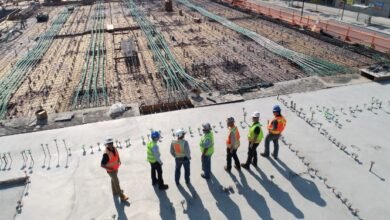Acoustic Screen Materials And Construction For HVAC Noise Reduction

In the bustling world of HVAC (Heating, Ventilation, and Air Conditioning) systems, noise reduction stands as a paramount concern. The relentless hum of machinery can disrupt productivity, disturb peace, and even affect health. Thankfully, the integration of acoustic screens has emerged as a key solution to mitigate these auditory intrusions. In this comprehensive exploration, we delve into the realm of acoustic screen materials and construction, uncovering the strategies and innovations driving HVAC noise reduction.
The Need For Noise Reduction
Before delving into the specifics of acoustic screens, it’s crucial to grasp the significance of noise reduction in HVAC systems. Traditional HVAC units, especially those in commercial and industrial settings, can produce considerable noise levels due to the operation of compressors, fans, and motors. Aside from being annoying, this noise can actually be harmful to people’s health, leading to issues including stress, hearing loss, and disrupted sleep. Moreover, in urban environments, noisy HVAC systems can contribute to overall noise pollution, impacting the quality of life for residents.
The Role Of Acoustic Screens
Acoustic screens, also known as sound barriers or noise barriers, serve as protective shields against unwanted noise generated by HVAC equipment. By strategically placing these screens around noisy components, such as chillers, air handling units, and condensers, engineers can contain and redirect sound waves, effectively reducing noise emissions.
Materials Matter: Choosing The Right Components
The efficacy of acoustic screens hinges significantly on the selection of appropriate materials. Engineers and designers must consider various factors, including acoustic performance, durability, weather resistance, and aesthetics. Common materials used in the construction of acoustic screens include:
Sound-Absorbing Panels:
These panels are often made from porous materials such as fiberglass, mineral wool, or acoustic foam. Their porous structure allows them to absorb sound waves, converting acoustic energy into heat. Sound-absorbing panels are highly effective in reducing high-frequency noise but may require additional support for low-frequency attenuation.
Mass-Loaded Vinyl (Mlv):
MLV is a dense, flexible material that adds mass to acoustic screens, thereby improving their soundproofing capabilities. It is commonly used as a barrier layer in combination with other materials to block airborne noise transmission. Applications, where the noise from HVAC equipment spans a broad frequency range, are perfect for MLV because of its exceptional ability to reduce low-frequency noise.
Metal Sheets:
Metal sheets, such as steel or aluminum, are often used as structural components in acoustic screens. Their rigid construction provides support and stability, ensuring the longevity of the barrier system. Additionally, metal sheets can be perforated to enhance sound absorption while maintaining structural integrity.
Composite Materials:
Composite materials, combining different elements such as polymers, fibers, and fillers, offer a versatile solution for acoustic screen construction. These materials can be engineered to exhibit specific acoustic properties, making them suitable for diverse applications. Composite panels may feature a sandwich structure, with a core material providing acoustic insulation sandwiched between outer layers for protection and aesthetics.
Constructing Effective Acoustic Screens
Innovative construction techniques now integrate rafter mounted mechanical platforms into acoustic screen installations, maximizing space efficiency and minimizing visual impact while effectively reducing noise pollution from HVAC systems. Building a successful acoustic screen requires careful planning and meticulous execution. The following steps outline the construction process:
Site Assessment:
Find any potential barriers, sensitive receptors, or sources of noise by doing a comprehensive site assessment. This evaluation will inform the placement and design of acoustic screens to achieve maximum noise reduction.
Design Considerations:
Collaborate with architects, engineers, and acoustic consultants to develop a tailored design for the acoustic screen. Consider factors such as site constraints, aesthetic requirements, airflow considerations, and local regulations governing noise levels.
Material Selection:
Consider the materials’ environmental friendliness, longevity, and acoustic qualities before making a final decision. Consider factors such as weather resistance, UV stability, and maintenance requirements when selecting materials for long-term performance.
Installation:
Follow best practices for installation to ensure the integrity and effectiveness of the acoustic screen. Proper anchoring, sealing, and reinforcement are essential to withstand environmental conditions and maintain structural stability.
Testing And Validation:
Conduct acoustic testing to verify the performance of the installed acoustic screen. Measure noise levels before and after installation to quantify the reduction achieved and ensure compliance with regulatory standards.
Maintenance And Monitoring:
Implement a regular maintenance program to inspect and maintain the acoustic screen over its lifecycle. Monitor noise levels periodically to detect any changes or deterioration in performance and address them promptly.
Innovations Driving Advancements
Advancements in materials science, manufacturing techniques, and computational modeling have fueled innovation in the field of acoustic screen materials and construction. Engineers and researchers are exploring novel materials with enhanced acoustic properties, such as metamaterials and acoustic metamaterials, which exhibit unconventional acoustic behaviors not found in natural materials. Acoustic screen designs can be optimised and modelled with more precision with the help of digital design tools and simulation software, which in turn improves performance and efficiency.
Conclusion
Acoustic screens play a vital role in mitigating noise pollution generated by HVAC systems, ensuring a quieter and more comfortable environment for occupants. By leveraging appropriate materials and construction techniques, engineers can design and install effective barriers that minimize noise emissions while maintaining optimal system performance. Noise will no longer be an issue for people’s comfort and well-being thanks to advancements in acoustic screen materials and construction made possible by ever-improving technology.







